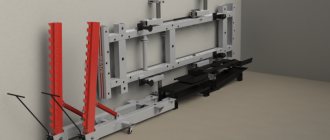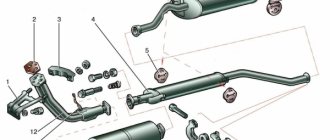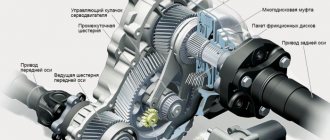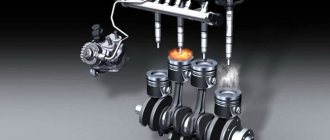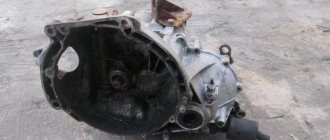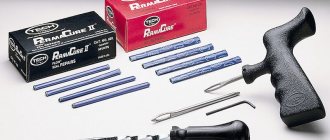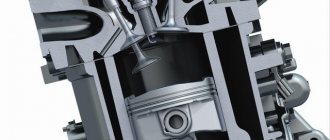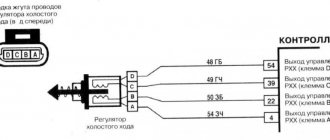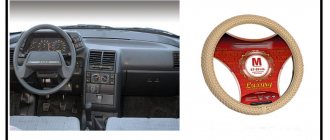A driveshaft is a unit that directly transmits torque (rotation energy) to the wheels. Beginners sometimes confuse the concepts of “propeller shaft” and “universal drive”. To prevent this from happening, it is important to learn the following things:
- The cardan shaft has two support points; there are no intermediate supports.
- A driveline drive may have multiple supports and includes multiple driveshafts.
Cardan shafts are easy to find in passenger vehicles (all-wheel drive and rear-wheel drive cars), light trucks, buses, dump trucks, trucks, truck cranes, loaders, tractors, ATVs. But driveshafts are unpopular among front-wheel drive cars. It is difficult to achieve synchronous rotation of the shafts. An exception is vehicles with a HF with a CV joint.
What is a cardan shaft
The cardan is a mechanism that transmits rotation from the gearbox to the rear axle gearbox. The task is complicated by the fact that these two mechanisms are located in different planes relative to each other. All car models whose rear wheels are driven are equipped with cardans.
The transmission driveshaft is installed along the vehicle's exhaust system and looks like a long beam running from the gearbox to the rear axle. It is equipped with at least two cross joints (one on each side), and in units with a slight offset of the axes - one.
A similar transmission is also used in the steering system of a car. The hinge connects the steering column with the steering mechanism located in a different plane.
In agricultural machinery, such a device is used to connect additional equipment to the tractor power take-off shaft.
From the history of the creation and use of the cardan
As most motorists know, only rear-wheel drive and all-wheel drive car models are equipped with a driveshaft. Vehicles with front drive wheels simply do not need this part of the transmission. In this case, torque is transmitted directly from the gearbox to the front wheels. a separate detailed review on why it is needed in a car and how it works ).
The world first learned about the principle of cardan transmission from the Italian mathematician, engineer and doctor Girolamo Cardano in the 16th century. The device named after him came into use at the end of the 19th century. One of the first auto developers to use this technology was Louis Renault.
Renault cars equipped with a cardan drive have a more efficient transmission. It eliminated torque dips in the process of transmitting it to the rear wheels when the vehicle encountered an unstable road. Thanks to this modification to the transmission, the cars became smoother while driving (without jerking).
Over the decades of vehicle modernization, the cardan drive principle has remained intact. As for the design of such a transmission, depending on the car model, it can differ greatly from related analogues.
What can break? how should the failure occur?
It would seem that the driveshaft is an extremely simple element in which very little can break. In practice, the list of possible failures is surprisingly long:
- The rubber of the shaft support is broken - there is nothing to repair, it needs to be replaced. And as soon as possible.
- A worn driveshaft support is the most common consequence of severe wear in the drive system and is a consequence of very high mileage on the vehicle.
Read news about the new Niva
- Generator Niva 2121, 21213, 21214: which one is installed, replacement
- Toyota Wish 1.8 XS package 2003 - 2004: technical specifications, prices and photos
- Creating a reinforced bumper for Niva
- Heater taps VAZ 21214 - buy in Balashikha at a bargain price
- Farewell chord: LADA 4×4 Bronto frees up the production line for a new generation
- Diagram for switching on direction indicators and hazard warning lights (before 2009) Chevrolet Niva.
- Winter off-road tires - what can be installed, look at studded and non-studded models
- Recommendations for selecting a winch for an SUV or ATV.
Cardan shaft device
The cardan mechanism includes the following elements.
1. Central shaft. It is made of hollow steel pipe. The void is necessary to facilitate the structure. On one side of the pipe there are internal or external slots. They are necessary to install the sliding fork. A hinge fork is welded on the other side of the pipe.
2. Intermediate shaft. Multi-section modifications of cardans use one or more of these elements. They are installed on rear-wheel drive cars to eliminate vibration that occurs when a long pipe rotates at high speeds. Fixed hinge forks are attached to them on both sides. Sports cars use single-section universal joints.
3. Cross. This is a hinge element with tips, inside of which there is a needle bearing. The part is installed in the fork eyes. It transmits rotation from the drive fork to the driven fork. Additionally, they ensure unhindered rotation of two shafts, the angle of inclination of which does not exceed 20 degrees. If the difference is greater, another intermediate section is installed.
4. Suspension bearing. It is mounted in the mount of the additional section. This part fixes and stabilizes the rotation of the intermediate shaft. The number of these bearings is identical to the number of intermediate sections.
5. Sliding fork. It is inserted into the central shaft. When the car is moving, the distance between the axle and the gearbox is constantly changing due to the operation of the shock absorbers. If you fix the pipe tightly, at the very first bump you will need to change some unit (the one that will be weakest). This could be a broken shaft mount or failure of bridge parts. The sliding fork is equipped with splines. Depending on the modification, it is either inserted into the central shaft (corresponding grooves are made inside it) or placed on top of the pipe. Splines and grooves are needed for the pipe to rotate the hinge.
6. Hinge forks. They connect the central shaft to the intermediate shaft. The fork-flange has a similar shape, only it is installed at the place where the entire mechanism is attached at the front to the gearbox, and at the rear to the axle gearbox.
7. Elastic coupling. This part softens the impacts of the cardan when it moves while driving. It is installed between the flange of the output shaft of the box and the fork flange of the central cardan shaft.
Service
The crosspieces in some shafts provide for changing the lubricant through grease nipples. For injection, a syringe is used that injects lubricant under pressure.
The lubricant itself must be specifically designed for crosspieces; universal compounds do not work well here. The same applies to lubrication of spline joints.
It is better to carry out maintenance operations after each exposure to difficult road conditions when liquid dirt and water come into contact with the hinge. The joint must be injected until all four cups of clean injected lubricant begin to emerge from under the seals.
What function does it perform?
The main task of this mechanism is to transmit rotational movements to axes located in different planes. The gearbox is located higher than the rear wheel axle of the car. If you install a straight beam, due to the displacement of the axes, it will either break itself or break the frame and bridge assemblies.
Another reason why this device is needed is the mobility of the rear axle of the machine. It is mounted on shock absorbers, which move up and down while driving. In this case, the distance between the gearbox and the rear gearbox is constantly changing. The sliding fork compensates for such differences without losing torque.
